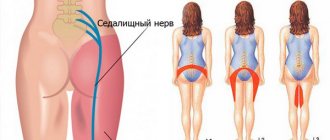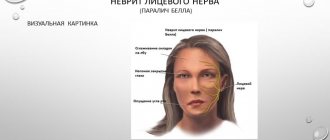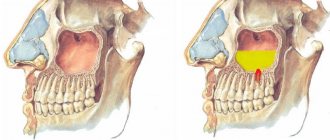- Facial neuritis is an inflammatory disease that causes partial, unilateral paralysis or paresis of the face.
The facial nerve is responsible for contractions of facial muscles and consists primarily of motor fibers. It is one of twelve paired cranial nerves. It begins in the brain and, branching, innervates the face. Its inflammation can occur both at the base (in the core area) and throughout, involving one or more branches. Depending on this, the symptoms of the disease vary.
In most cases, treatment of neuritis of the facial nerve is carried out using conservative methods, and only in the most severe cases (for example, with injuries with a complete rupture of the nerve canal), if therapy is ineffective, surgical treatment is used.
At the Tibet Clinic, treatment of neuritis of the facial nerve is carried out without surgery, using reflexology and physiotherapy. Positive results are achieved in 97 - 98% of cases.
As a result of treatment, contractions of the facial muscles and facial symmetry are restored, spasticity and other symptoms disappear, and the inflammatory process is stopped. These results are long-term and persistent.
Information about the disease
The facial nerve is responsible for ensuring the movements of facial muscles, the lacrimal gland, the tensor tympani muscle, and also innervates the anterior two-thirds of the tongue. It leaves the skull in a narrow canal located deep in the temporal bone. The slightest swelling in this area leads to compression of the fibers and the development of corresponding symptoms.
The pathology most often occurs in middle-aged people, who often neglect preventive measures due to the high pace of life. The peak incidence occurs in the cold season, since low temperatures are one of the provoking factors.
Make an appointment
Psychosomatics in the treatment of trigeminal neuralgia
From the point of view of the psychosomatic approach, a symptom is a bodily expression of an unresolved problem at the level of the human psyche. Like a red light on a dashboard, it signals problems and draws our attention to them. Awareness and resolution of the problem lead to healing and, as a result, to the disappearance of symptoms that become unnecessary (the red light changes to green). Sometimes psychological work to change lifestyle (mental, emotional, physical habits) is enough for complete recovery. Sometimes the body needs additional help in the form of one or another cleansing and healing effect.
Rudiger Dahlke and Thorvald Detlefsen in the book “Disease as a Path” advise people suffering from trigeminal neuralgia to ask themselves questions that will help find the root of the problem and its solution: 1. What pain is written on my face? Where is my sensitivity impaired? 2. What prevents me from feeling at ease? 3. What criticism do I have to hide? 4. What does a “bad game” mean when I put on a “good face”? 5. Who were the intended recipients of the suppressed blows that “burn” on my face? 6. Where do I lack self-affirmation? 7. What does my accumulated energy want to do now?
Make an appointment
Causes
Depending on the cause, the following forms of facial nerve neuropathy are distinguished:
- idiopathic: the cause of paralysis remains unidentified (the most common variant of the disease);
- infectious: pathology occurs against the background of infectious damage to nerve fibers due to herpes, tuberculosis, mumps, syphilis and some other diseases;
- otogenic: is a complication of inflammation of the middle ear or mastoid process;
- traumatic: neuropathy develops against the background of traumatic brain injury;
- ischemic: the disease is associated with impaired blood flow and decreased oxygen supply to nerve fibers.
The risk of pathology increases significantly in the following situations:
- for metabolic disorders, including diabetes mellitus;
- with advanced forms of arterial hypertension;
- during pregnancy, especially with severe toxicosis.
The triggering factor for the development of pathology is often hypothermia.
Location and functions of the facial nerve
The facial nerve controls muscle movements in this anatomical region. This gives a person the opportunity to smile, express emotions with facial expressions, cry, and wink. Facial neuritis can lead to severe physical disability that is poorly tolerated psychologically. Although in most cases the symptoms of the disease gradually disappear, this requires long-term rehabilitation.
The facial nerve is the seventh of 12 paired cranial nerves. Each person has 2 facial nerves, corresponding to the right and left halves of the face. This nerve is adjacent to the eighth nerve, the auditory nerve, and passes through the structures of the middle ear, the mastoid process, and the parotid salivary gland, where it splits into many small branches.
Symptoms
Symptoms of facial neuropathy make it possible to immediately suspect the disease. Signs arise from the affected nerve. Patients note:
- acute pain: it usually begins in the ear area and gradually spreads throughout the face and begins to radiate to the occipital region;
- intense lacrimation, less often dry mucous membranes of the eyes;
- discomfort or ringing in the ear due to sharp sounds;
- disturbance of the sense of taste in the anterior parts of the tongue.
As the disease progresses, signs of damage to the motor fibers of the nerve appear:
- smoothness of skin folds, especially nasolabial folds;
- swelling of the cheek when exhaling or trying to pronounce a consonant sound;
- lack of complete closure of the eyelids, rotation of the eyeball upward and outward (lagophthalmos);
- leakage of fluid from the corner of the mouth;
- food getting stuck between the gum and cheek when eating;
- limitation of facial expressions: the patient cannot frown or smile.
If the cause of neuropathy is an infectious process, the characteristic signs are accompanied by symptoms of general intoxication:
- high body temperature;
- headache;
- nausea and vomiting;
- weakness.
Symptoms of neuralgia
- Facial pain (prosopalgia). A characteristic sign of neuralgia. Sharp and sudden, reminiscent of an electric shock. Usually lasts from 5 to 15 seconds, is paroxysmal in nature and can occur at any time. During periods of remission, the number of attacks decreases. Most often, pain occurs in the area of the cheekbones and lower jaw (both right and left), and can be localized in almost all areas of the face.
- Impaired sensitivity. A severe form of neuralgia can lead to partial or complete loss of sensitivity of the skin.
- Nervous tic of the eyelid (nystagmus), spasms and twitching of facial muscles.
- Loss of coordination and motor skills are rarer manifestations of severe forms of the disease.
- Headaches, fever, chills and weakness are syndromes caused by viruses and infections.
Diagnostics
Neurological disorders characteristic of facial neuropathy can also occur with other diseases, in particular with stroke. That is why, if any similar symptoms occur, you should urgently consult a neurologist.
Diagnosis of pathology includes:
- collection of complaints;
- taking an anamnesis, during which the doctor clarifies the time and circumstances of the onset of symptoms, records previous and chronic diseases, injuries and other important details;
- neurological examination, during which a specialist checks skin sensitivity, motor function, muscle strength, quality of reflexes, functioning of the central nervous system, etc.;
- tests: general blood and urine analysis, biochemical blood test with mandatory determination of glucose levels, determination of antigens and antibodies to infectious diseases if their presence is suspected;
- X-ray of the chest organs: allows you to diagnose tuberculosis, tumors;
- MRI or CT scan of the brain: helps visualize tumors, areas of acute ischemia, hemorrhages, consequences of injuries and strokes;
- CT scan of the temporal bone;
- electroneuromyography: assessment of the speed of impulse transmission along nerve fibers and muscles, allows you to determine the level of damage and severity of the disease;
- consultations with specialists: therapist, otorhinolaryngologist, endocrinologist, infectious disease specialist, if necessary.
The list of studies can be adjusted depending on the specific clinical situation.
Types and scheme of physical treatment
There are a large number of types of physiotherapy. And each has its own characteristics and mechanism of action. The treatment plan is described below.
- Before each stage of treatment, electromyography is required. This allows you to assess the degree of excitability and conductivity of the nerve fiber and correctly configure the equipment parameters.
- On 2-3 days after diagnosis, heat treatment can be performed in the affected area. Sollux lamp and Minin reflector use infrared rays to improve blood circulation, reduce pain, and reduce swelling. Due to the small size of the reflector, you can buy it at a pharmacy and use it at home.
- Manual massage of the occipital and behind-the-ear areas, collar area. Finger pressure dilates blood vessels and accelerates the regeneration process. An easy but effective home method to improve blood flow.
- Myogymnastics is recommended from the very beginning until the end of treatment. The goal is to avoid contractures and teach facial muscles to work correctly.
- Electrophoresis for neuritis of the facial nerve can be performed from the 4th-5th day of the disease. It is carried out using a Bergonier half mask. Thanks to electric currents and the formation of a depot, the effect of medicinal substances occurs quickly and lasts for a very long time. Potassium iodide, vitamin B1, calcium chloride, novocaine, magnesium sulfate, proserin, aminophylline and others are used as medications.
- UHF and UV therapy has an anti-inflammatory, regenerative effect and stimulates tissue trophism. Ural irradiation has antiviral and bactericidal effects.
- From 10-14 days of illness, laser, SMV or ultrasound therapy, magnetic therapy, myoelectric stimulation, and darsonvalization can be performed. Under the influence of current, magnetic field or laser, blood circulation and nerve fiber regeneration improves. Everyone has the opportunity to buy a Darsonval device at a pharmacy and use it at home.
- After 1-2 months, paraffin treatment and ozokerite applications are used. Helps restore damaged tissues and improve blood flow. Can be performed both on an outpatient basis and at home. But do not forget to take precautions.
- After completing the full course of treatment for rehabilitation, it is better to go to a sanatorium or resort with a favorable climate. It is important not to overload the nervous system, strengthen the immune system, and treat all systemic diseases. All this will speed up recovery and reduce the risk of relapse.
After diagnosis, a competent specialist will select the optimal treatment plan for you. There is no need to self-medicate or try to undergo all types of physical procedures that exist on your own. The process of restoring nerve fibers and muscles is quite long and difficult.
Physiotherapy for facial neuritis is one of the most common procedures performed in a hospital. The ratio of the number of cases to the population is 25 to 100 thousand.
Treatment of facial nerve neuropathy
A combination of drug and non-drug methods is used for treatment. As a rule, doctors prescribe medications from these groups:
- non-steroidal anti-inflammatory drugs (NSAIDs): ibuprofen, meloxicam, nimesulide, diclofenac and other drugs; necessary to relieve pain and inflammation, eliminate swelling; used for mild to moderate neuropathy;
- glucocorticosteroids: prednisolone, hydrocortisone, dexamethasone; have an anti-inflammatory effect, relieve swelling; used for severe forms of the disease, as well as when NSAIDs are ineffective;
- diuretics: furosemide, lasix; necessary to eliminate tissue swelling;
- vascular drugs: pentoxifylline, nicotinic acid, cavinton; stimulate active blood flow in the affected area, improve tissue nutrition;
- metabolic agents: actovegin; necessary to stimulate metabolism and regenerate damaged structures;
- antiviral and antibacterial agents for the infectious nature of the pathology;
- anticholinesterase drugs: neuromidin, axamon; improve the transmission of excitation from nerve to muscle, help to quickly get rid of paralysis of facial muscles;
- B vitamins: milgamma, combilipen; stimulate nerve regeneration and improve impulse conduction.
If neuropathy has become chronic and muscle paresis has given way to spasm, muscle relaxants are prescribed: mydocalm, carbamazepine, baclofen. They replace anticholinesterase drugs and promote muscle relaxation. If these remedies are ineffective, injections based on botulinum toxin are used.
Drug treatment is complemented by physiotherapy. In the acute period the following are used:
- UHF;
- exposure to alternating magnetic field;
- phonophoresis with hormones.
After one and a half to two weeks from the onset of the disease, these methods are added:
- electrotherapy (diadynamic currents, etc.);
- electrical stimulation of muscles;
- electrophoresis;
- magnetic therapy;
- laser therapy;
- Darsonvalization.
An additional effect is provided by mud applications, therapeutic baths, and acupuncture.
During the acute period it is also recommended:
- sleep only on your side (affected side);
- tie a scarf around your face to prevent stretching of paralyzed muscles;
- carry out muscle taping: tighten the muscles using an adhesive plaster (duration from 30-60 minutes to 2-3 hours);
- tilt your head in the direction of the lesion several times a day and support the muscles with your palm; The duration of the procedure is 10-15 minutes.
After acute inflammation has subsided, it is recommended to perform therapeutic exercises to develop the affected muscles:
- frown and raise your eyebrows;
- open and close your eyes wide;
- widen the nostrils;
- puff out one's cheeks;
- smile with your mouth open and closed;
- stretch out your lips, blow out an imaginary candle, whistle;
- stick out tongue, etc.
The more the patient grimaces, the faster the muscles will recover. During the same period, a light therapeutic massage to stimulate blood circulation is acceptable.
If treatment does not bring effect within 2-3 months, doctors recommend using surgical treatment methods. Two types of operations are used:
- restoration of impulse transmission along the nerve: decompression of the nerve fiber when it is compressed in the canal of the temporal bone;
- reinnervation: replacement of the affected area with a donor nerve (segment of the hypoglossal, phrenic or accessory nerve, as well as healthy branches of the facial nerve);
- partial suturing of the eyelids (tarsophasia);
The choice of a specific treatment method depends on the form of the disease, its cause, severity and level of damage.
Make an appointment
Otogenic neuritis of the facial nerve
Neuritis of the facial nerve, which occurs secondary to serious diseases of the middle ear, requires urgent surgery. During the intervention, the doctor relieves excess pressure on the nerve (decompresses it) by removing part of the bone wall of the nerve canal that runs in the middle ear. Subsequently, treatment of the underlying disease is prescribed, as a result of which the function of the affected facial nerve is also restored.
If the pathology develops at an early stage of acute otitis media, a decision may be made on conservative treatment of facial neuritis:
- vitamin therapy with ascorbic acid and group B preparations (Milgamma);
- decongestants (furosemide);
- glucocorticoids for rapid relief of inflammation and pain;
- after acute manifestations subside, actovegin, solcoseryl, and other drugs that affect the metabolism of nervous tissue are prescribed;
- If conservative treatment is ineffective, different types of surgical interventions are prescribed.
Physiotherapeutic methods are included in the complex of restorative treatment measures:
- therapy with UHF, quartz radiation, laser;
- electrophoresis with B vitamins, lidase;
- acupuncture and massage, especially performed on the inside of the cheek;
- applications of therapeutic mud, ozokerite, paraffin;
- physical therapy aimed at restoring the activity of the muscles of the lower part of the face.
Prevention
Compliance with the rules for the prevention of facial nerve neuropathy can reduce the likelihood of pathology occurring. This is especially true if there is an increased risk of developing the disease. Doctors recommend:
- avoid hypothermia and facial injuries;
- observe safety precautions at work to prevent eye damage;
- consult a doctor in time for infections and otitis media;
- control blood sugar levels;
- promptly diagnose and treat chronic diseases.
Causes of trigeminal neuralgia
Why and how does such severe pain occur? There is no final answer yet, although the search for it has been going on for centuries.
One of the immediate causes of pain is considered to be the destruction of the “insulation” of the nerve - the so-called. myelin sheath, when it is inflamed. In this case, “short circuits” and “leakages” of the electrical signal occur outside the nerve fiber. As a result of the chaotic involvement of a large number of neurons in the process of excitation, pain occurs.
The immediate cause of destruction of the myelin sheath can be:
- viral infection (poliomyelitis, neuro-AIDS, herpes);
- autoimmune process (for example, with multiple sclerosis);
- mechanical compression of the trigeminal nerve fibers inside or outside the skull.
Nerve compression is caused by:
- hemorrhages (stroke);
- dilation and curvature of blood vessels (atherosclerosis, aneurysms);
- facial and head injuries;
- pathology of the maxillary system;
- neoplasms;
- the presence of adhesions (for example, due to meningitis), etc.
Nerve degeneration sooner or later leads to malfunctions in the “remote control” of its control—the sensory and motor nuclei located in the brain. And it even contributes to the formation of areas of increased excitability - the so-called. epileptic foci. Damage to the nuclei can also be primary (its causes are also present in the above list).
Treatment at the Energy of Health clinic
Facial nerve neuropathy requires the fastest and most accurate diagnosis and comprehensive, comprehensive treatment. Only in this case can a rapid restoration of impaired functions be achieved. Neurologists at the Energy of Health clinic use the most effective techniques:
- modern drug regimens that affect the cause of the disease and relieve symptoms;
- physiotherapy courses for tissue restoration;
- massotherapy;
- training in facial gymnastics techniques;
- taping the affected areas;
- observation throughout therapy, adjustment of dosages and medications if necessary;
- a full range of measures for quick and complete rehabilitation;
- organization of sanatorium-resort treatment for the most complete recovery.
Advantages of the clinic
The Health Energy Clinic provides each visitor with medical care of the highest level, regardless of his age and reason for visiting. We offer:
- screening diagnostic programs to assess health status;
- accurate and quick diagnosis of obvious and hidden pathologies;
- modern methods of drug therapy, physiotherapy, exercise therapy, massage;
- minor surgical operations within the walls of the clinic;
- course treatment of chronic diseases in comfortable day care wards;
- organization of hospitalization in a specialized hospital if necessary;
- preparation of documents for sanatorium-resort treatment, selection of sanatorium;
- remote consultations with foreign doctors to obtain an alternative opinion;
- modern rehabilitation programs.
Facial nerve neuropathy is a fairly common pathology. To prevent it from leading to irreversible facial asymmetry, contact a specialist as soon as possible. Neurologists at the Energy of Health clinic will always come to the rescue.











